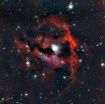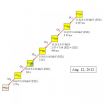(Press-News.org) Squamous cell carcinoma (SCC) is diagnosed in about 700,000 people in the United States every year. Commonly contributing to SCC is a protein called DNp63a – it goes abnormally high and the ability of a patient's body to kill cancer cells goes abnormally low. In many cases of SCC, it's just that simple. And science thought the function of DNp63a was simple, as well: the tumor suppressor gene p53 is responsible for recognizing and killing cancer cells, and in SCC, it's usually inactivated. It looked like high DNp63a repressed p53, made SCC.
A University of Colorado Cancer Center study published today in the journal Genes & Development throws the accepted role of DNp63a on its ear. Though high DNp63a and low p53 activity are correlated in SCC, there's no causation – DNp63a doesn't affect p53. Instead, DNp63a employs "epigenetics" to keep cancer cells alive.
"This is a potent oncogene whose mechanism we thought we knew. But basically in this paper we demolish the accepted model. DNp63a doesn't work through p53 – it operates through epigenetic silencing of anti-proliferative genes," says the study's senior author, Joaquin M. Espinosa, PhD, investigator at the CU Cancer Center and associate professor in the Department of Molecular, Cellular and Developmental Biology at CU Boulder.
Genes are blueprints that code for proteins and these proteins in turn drive most things that happen in the body, both good and bad. But between genes and their protein products is the layer of epigenetics – genes may be expressed differently depending on the heritable, epigenetic features that turn them on and off. In the case of DNp63a, it employs a protein partner called H2A.Z, which in volume effectively buries anti-proliferative genes in silt, rendering them unable to go about their anti-cancer duties.
"Independently of p53, DNp63a is shutting down genes that stop cell division – shutting down anti-proliferative genes so that cells can keep dividing and dividing and dividing," Espinosa says.
Now that the function of DNp63a is known, Espinosa is looking inside the chain of events for a breakable link.
"DNp63a itself isn't druggable," he says, "but the enzymes that partner with DNp63a for epigenetic silencing are."
With a mechanism in hand, Espinosa and colleagues can now explore in animal models the possible effects of breaking the DNp63a mechanism. Drug away an essential enzyme and DNp63a may lose its ability to cause cancer.
### END
Study pinpoints epigenetic function of common cancer-causing protein – it's not what science thought
Protein DNp63a makes squamous cell carcinoma, but not through gene p53, as thought
2012-09-26
ELSE PRESS RELEASES FROM THIS DATE:
The rich colors of a cosmic seagull
2012-09-26
Nebulae are among the most visually impressive objects in the night sky. They are interstellar clouds of dust, molecules, hydrogen, helium and other ionised gases where new stars are being born. Although they come in different shapes and colours many share a common characteristic: when observed for the first time, their odd and evocative shapes trigger astronomers' imaginations and lead to curious names. This dramatic region of star formation, which has acquired the nickname of the Seagull Nebula, is no exception.
This new image from the Wide Field Imager on the MPG/ESO ...
Search for element 113 concluded at last
2012-09-26
The most unambiguous data to date on the elusive 113th atomic element has been obtained by researchers at the RIKEN Nishina Center for Accelerator-based Science (RNC). A chain of six consecutive alpha decays, produced in experiments at the RIKEN Radioisotope Beam Factory (RIBF), conclusively identifies the element through connections to well-known daughter nuclides. The groundbreaking result, reported in the Journal of Physical Society of Japan, sets the stage for Japan to claim naming rights for the element.
The search for superheavy elements is a difficult and painstaking ...
Researchers uncover biochemical events needed to maintain erection
2012-09-26
For two decades, scientists have known the biochemical factors that trigger penile erection, but not what's needed to maintain one. Now an article by Johns Hopkins researchers, scheduled to be published this week by the Proceedings of the National Academy of Sciences (PNAS), uncovers the biochemical chain of events involved in that process. The information, they say, may lead to new therapies to help men who have erectile dysfunction.
"We've closed a gap in our knowledge," says Arthur Burnett, M.D., professor of urology at Johns Hopkins Medicine and the senior author ...
Moffitt Cancer Center researchers say smoking relapse prevention a healthy step for mothers, babies
2012-09-26
Researchers at Moffitt Cancer Center, concerned that women who quit smoking during their pregnancies often resume smoking after they deliver their baby, tested self-help interventions designed to prevent postpartum smoking relapse.
"We'd first like to see more women quit smoking when they become pregnant," said Thomas H. Brandon, Ph.D., senior member at Moffitt and chair of the Department of Health Outcomes and Behavior. "However, even among those who do quit, the majority return to smoking shortly after they give birth."
According to the researchers, nearly 50 percent ...
Severe hunger increases breast cancer risk in war survivors
2012-09-26
Jewish women who were severely exposed to hunger during World War Two were five times more likely to develop breast cancer than women who were mildly exposed, according to research in the October issue of IJCP, the International Journal of Clinical Practice.
The study also found that women who were up to seven-years-old during that period had a three times higher risk of developing breast cancer than women who were aged 14 years or over.
Sixty-five women diagnosed with breast cancer between 2005 and 2010 were compared with 200 controls without breast cancer. All ...
Slave rebellion is widespread in ants
2012-09-26
Ants that are held as slaves in nests of other ant species damage their oppressors through acts of sabotage. Ant researcher Professor Dr. Susanne Foitzik of Johannes Gutenberg University Mainz (JGU) in Germany first observed this "slave rebellion" phenomenon in 2009. According to the latest findings, however, this behavior now appears to be a widespread characteristic that is not limited to isolated occurrences. In fact, in three different populations in the U.S. states of West Virginia, New York, and Ohio, enslaved Temnothorax longispinosus workers have been observed to ...
Learning requires rhythmical activity of neurons
2012-09-26
This press release is available in German.
The hippocampus represents an important brain structure for learning. Scientists at the Max Planck Institute of Psychiatry in Munich discovered how it filters electrical neuronal signals through an input and output control, thus regulating learning and memory processes. Accordingly, effective signal transmission needs so-called theta-frequency impulses of the cerebral cortex. With a frequency of three to eight hertz, these impulses generate waves of electrical activity that propagate through the hippocampus. Impulses of a different ...
New AACP Practice Parameter on gay, lesbian, bisexual, and gender variant issues
2012-09-26
Washington D.C., September 26, 2012 – The American Academy of Child and Adolescent Psychiatry (AACAP) is proud to announce its new Practice Parameter on issues related to and affecting gay, lesbian, bisexual, and gender variant youth.
Gay, lesbian, bisexual, and gender variant children and adolescents face unique developmental challenges and stressors that can influence their mental health and wellbeing. Social issues such as stigma, bullying, and discrimination, and personal factors like internalized prejudice and feelings of being different are just a few of the concerns ...
Melatonin and exercise work against Alzheimer's in mice
2012-09-26
The combination of two neuroprotective therapies, voluntary physical exercise, and the daily intake of melatonin has been shown to have a synergistic effect against brain deterioration in rodents with three different mutations of Alzheimer's disease.
A study carried out by a group of researchers from the Barcelona Biomedical Research Institute (IIBB), in collaboration with the University of Granada and the Autonomous University of Barcelona, shows the combined effect of neuroprotective therapies against Alzheimer's in mice.
Daily voluntary exercise and daily intake ...
New simulation method produces realistic fluid movements
2012-09-26
What does a yoghurt look like over time? The food industry will soon be able to answer this question using a new fluid simulation tool developed by the Department of Computer Science (DIKU) at the University of Copenhagen as part of a broad partnership with other research institutions. An epoch-making shift in the way we simulate the physical world is now a reality.
A five-year collaboration between the University of Copenhagen, the Technical University of Denmark (DTU) and the Alexandra Institute on simulating fluids in movement is now bearing fruit, and has earned the ...
LAST 30 PRESS RELEASES:
Normalizing blood sugar can halve heart attack risk
Lowering blood sugar cuts heart attack risk in people with prediabetes
Study links genetic variants to risk of blinding eye disease in premature infants
Non-opioid ‘pain sponge’ therapy halts cartilage degeneration and relieves chronic pain
AI can pick up cultural values by mimicking how kids learn
China’s ecological redlines offer fast track to 30 x 30 global conservation goal
Invisible indoor threats: emerging household contaminants and their growing risks to human health
Adding antibody treatment to chemo boosts outcomes for children with rare cancer
Germline pathogenic variants among women without a history of breast cancer
Tanning beds triple melanoma risk, potentially causing broad DNA damage
Unique bond identified as key to viral infection speed
Indoor tanning makes youthful skin much older on a genetic level
Mouse model sheds new light on the causes and potential solutions to human GI problems linked to muscular dystrophy
The Journal of Nuclear Medicine ahead-of-print tip sheet: December 12, 2025
Smarter tools for peering into the microscopic world
Applications open for funding to conduct research in the Kinsey Institute archives
Global measure underestimates the severity of food insecurity
Child survivors of critical illness are missing out on timely follow up care
Risk-based vs annual breast cancer screening / the WISDOM randomized clinical trial
University of Toronto launches Electric Vehicle Innovation Ontario to accelerate advanced EV technologies and build Canada’s innovation advantage
Early relapse predicts poor outcomes in aggressive blood cancer
American College of Lifestyle Medicine applauds two CMS models aligned with lifestyle medicine practice and reimbursement
Clinical trial finds cannabis use not a barrier to quitting nicotine vaping
Supplemental nutrition assistance program policies and food insecurity
Switching immune cells to “night mode” could limit damage after a heart attack, study suggests
URI-based Global RIghts Project report spotlights continued troubling trends in worldwide inhumane treatment
Neutrophils are less aggressive at night, explaining why nighttime heart attacks cause less damage than daytime events
Menopausal hormone therapy may not pose breast cancer risk for women with BRCA mutations
Mobile health tool may improve quality of life for adolescent and young adult breast cancer survivors
Acupuncture may help improve perceived breast cancer-related cognitive difficulties over usual care
[Press-News.org] Study pinpoints epigenetic function of common cancer-causing protein – it's not what science thoughtProtein DNp63a makes squamous cell carcinoma, but not through gene p53, as thought



